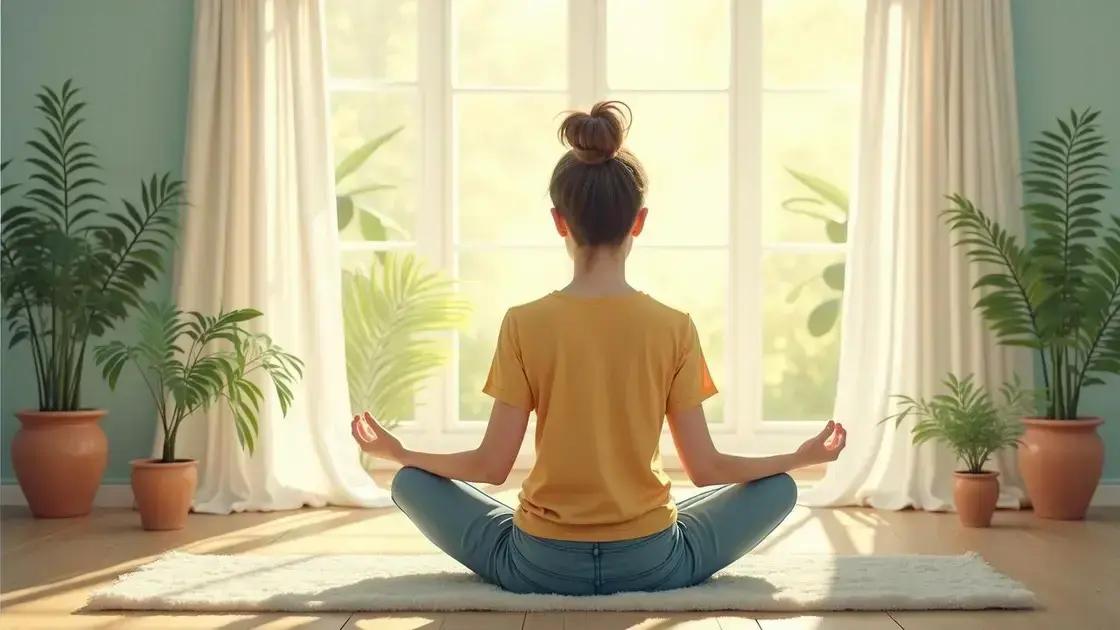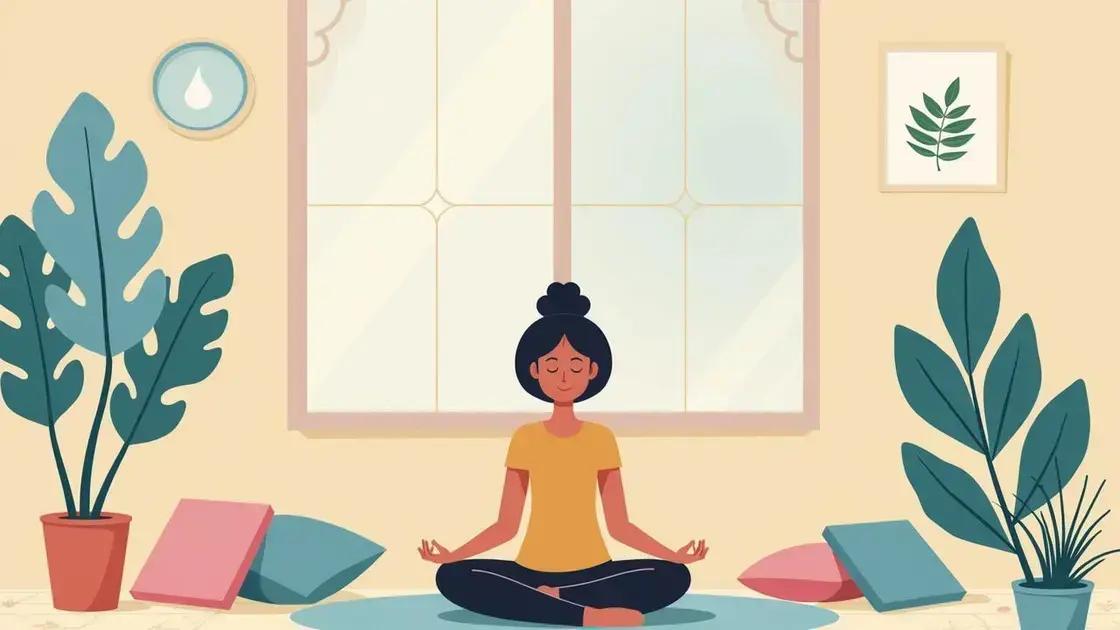Guided meditation is an effective way to manage stress, enhance focus, and improve emotional health; by setting a routine, creating a calming space, and using techniques such as focusing on breath, individuals can cultivate a consistent practice that promotes overall well-being.
Managing stress effectively is essential for maintaining mental health. Guided meditation is a powerful technique that can help individuals reduce anxiety, improve focus, and achieve a state of inner peace. In this post, we will explore the essence of guided meditation, its numerous benefits, and practical tips for incorporating it into your daily routine. Whether you’re a beginner or looking to deepen your practice, these insights will enhance your journey toward tranquility.
Understanding Guided Meditation

Guided meditation is a form of meditation that involves an instructor leading you through the session. This can be done in person or through audio and video recordings. The instructor provides guidance on focusing your thoughts, gaining awareness of your body, and achieving a deep state of relaxation. Understanding the process can help you tap into its full potential.
What is Guided Meditation?
Guided meditation combines techniques to help you visualize soothing scenes and encourage relaxation. The instructor will guide you step by step, helping you concentrate on specific images or feelings. This support can be particularly beneficial for those who are new to meditation or struggle to stay focused.
How it Works
During a guided meditation session, you typically close your eyes and follow the instructor’s voice. They will suggest breathing patterns, visualizations, and relaxation techniques that can aid in stress relief. You may imagine yourself in a peaceful setting, like a beach or forest, which can evoke feelings of calmness and tranquility.
Different Types of Guided Meditation
There are several styles of guided meditation, each serving different purposes. Some focus on relaxation, while others might be aimed at personal growth, self-discovery, or emotional healing. Finding a type that resonates with you is essential for consistency and effectiveness. Popular types include mindfulness meditation, loving-kindness meditation, and body scan meditation.
Why Understanding is Important
Knowing the fundamentals of guided meditation allows you to approach your practice with an open mind and realistic expectations. This knowledge encourages you to be patient as you develop your skills. As you understand how your mind and body react to different techniques, you can enhance your learning and experience greater benefits.
Benefits of Guided Meditation

Guided meditation offers numerous benefits that can significantly improve your mental and emotional health. Incorporating this practice into your daily routine can lead to enhanced quality of life. Here are some key benefits:
Reducing Stress
One of the primary advantages of guided meditation is its ability to reduce stress. As you focus on calming techniques and deep breathing, you allow your mind to release tension. This process helps your body to relax and can lower levels of cortisol, the hormone associated with stress.
Improving Focus and Concentration
Guided meditation encourages you to concentrate on your thoughts and feelings. This practice improves your focus, making it easier to stay on task. Over time, you may find that you can concentrate more effectively and for extended periods.
Enhancing Emotional Health
Engaging in guided meditation can lead to better emotional health. It promotes an increased sense of awareness and understanding of your feelings. Regular practice can help you manage anxiety and promote a more positive outlook on life.
Encouraging Better Sleep
Many people struggle with sleep issues. Guided meditation can aid in creating a restful environment for sleep. By calming your mind and body, you are more likely to fall asleep quickly and enjoy a restful night’s sleep.
Improving Self-Awareness
Through guided meditation, you can develop a greater sense of self-awareness. This practice encourages reflection and introspection, helping you understand your thoughts and behaviors better. This awareness can lead to personal growth and improved relationships.
Techniques to Stay Focused

Staying focused during guided meditation can be challenging, especially for beginners. However, implementing certain techniques can improve your focus and enhance your experience. Here are some effective methods:
1. Create a Calm Environment
Before starting your meditation, set up your space to promote calmness. Choose a quiet area free from distractions like noise or clutter. Use soft lighting or candles to create a soothing atmosphere.
2. Use a Guided Meditation App
Guided meditation apps can help you stay focused by providing structure. Many apps offer different lengths and styles of meditation, making it easy to find one that suits your needs. Follow along with the voice instructions, which can help keep your mind on track.
3. Focus on Your Breath
Your breath is a powerful anchor for your mind. Paying attention to each inhale and exhale can help you stay present. Whenever your thoughts wander, gently bring your focus back to your breathing, allowing your mind to settle.
4. Set a Timer
If you are new to meditation, a timer can reduce anxiety about how long you should meditate. Start with shorter sessions and gradually increase the time. Knowing that you will not be meditating indefinitely allows you to relax and focus.
5. Practice Regularly
Consistency is key in developing a focused meditation practice. Try to meditate at the same time each day. This regularity helps train your mind to enter a focused state more easily during each session.
6. Limit Multitasking
Before meditating, take a few moments to wind down and clear your mind. Limiting multitasking throughout your day can help reduce mental clutter. When you sit down to meditate, you can focus entirely on the practice instead of lingering thoughts from other tasks.
Creating Your Meditation Practice

Creating your meditation practice involves setting up a routine that works for you. Here are several steps to help you establish a consistent and enjoyable meditation practice:
1. Set a Clear Intention
Begin by defining why you want to meditate. Having a clear intention gives purpose to your practice. Whether it’s managing stress, improving focus, or enhancing well-being, knowing your goal can guide you.
2. Choose a Comfortable Space
Your environment should promote relaxation. Select a quiet, comfortable place where you can meditate without interruptions. You might decorate this space with calming items like plants, cushions, or soft lighting to make it inviting.
3. Decide on a Time
Choose a specific time of day to meditate. For many, mornings are ideal for starting the day with peace. However, others might prefer evenings to unwind. Consistency in timing helps to create a habit.
4. Start Small
When you’re new to meditation, start with short sessions. Aim for just five to ten minutes daily. As you become more comfortable, gradually increase the duration. This gradual approach makes it manageable and less intimidating.
5. Experiment with Different Techniques
There are various meditation techniques, such as mindfulness, visualization, or body scan. Explore different styles to find what resonates with you. This experimentation can keep your practice engaging and help you discover what works best.
6. Keep a Meditation Journal
After each session, take a moment to jot down your thoughts and feelings in a meditation journal. This helps track your progress and deepen self-reflection. You may notice patterns or changes in your emotions over time.
7. Be Patient with Yourself
Developing a meditation practice takes time and patience. It’s normal for your mind to wander. When it happens, gently guide your thoughts back to your breath or the meditation focus. Celebrate small victories in your progress.
Embracing Guided Meditation for a Stress-Free Life
Guided meditation is an effective tool for managing stress and enhancing overall well-being. By understanding its principles, recognizing its benefits, and applying practical techniques, you can create a personalized meditation practice that suits your lifestyle.
As you embark on or continue your meditation journey, remember to set intentions, choose a comfortable space, and remain patient with yourself. Through consistent practice, you can cultivate a sense of peace and resilience that positively impacts your daily life.
Incorporating guided meditation into your routine not only reduces stress but also offers the potential for improved emotional health, focus, and self-awareness. So, take the first step today toward a calmer, more centered you.
FAQ – Frequently Asked Questions about Guided Meditation
What is guided meditation?
Guided meditation is a practice where an instructor leads you through a meditative experience, helping you focus and relax.
How can guided meditation help manage stress?
Guided meditation helps reduce stress by encouraging relaxation and mindfulness, allowing you to focus on the present moment.
What are the best times to practice meditation?
Morning or evening are popular times for meditation. Choose a time that fits your schedule and allows for consistency.
How long should I meditate each day?
Start with 5 to 10 minutes and gradually increase the duration as you become more comfortable with the practice.
Do I need special equipment for meditation?
No special equipment is necessary. A quiet, comfortable space is all you need to begin your meditation practice.
What if I can’t focus during meditation?
If you find it difficult to focus, gently guide your thoughts back to your breath or the instruction without self-judgment.












